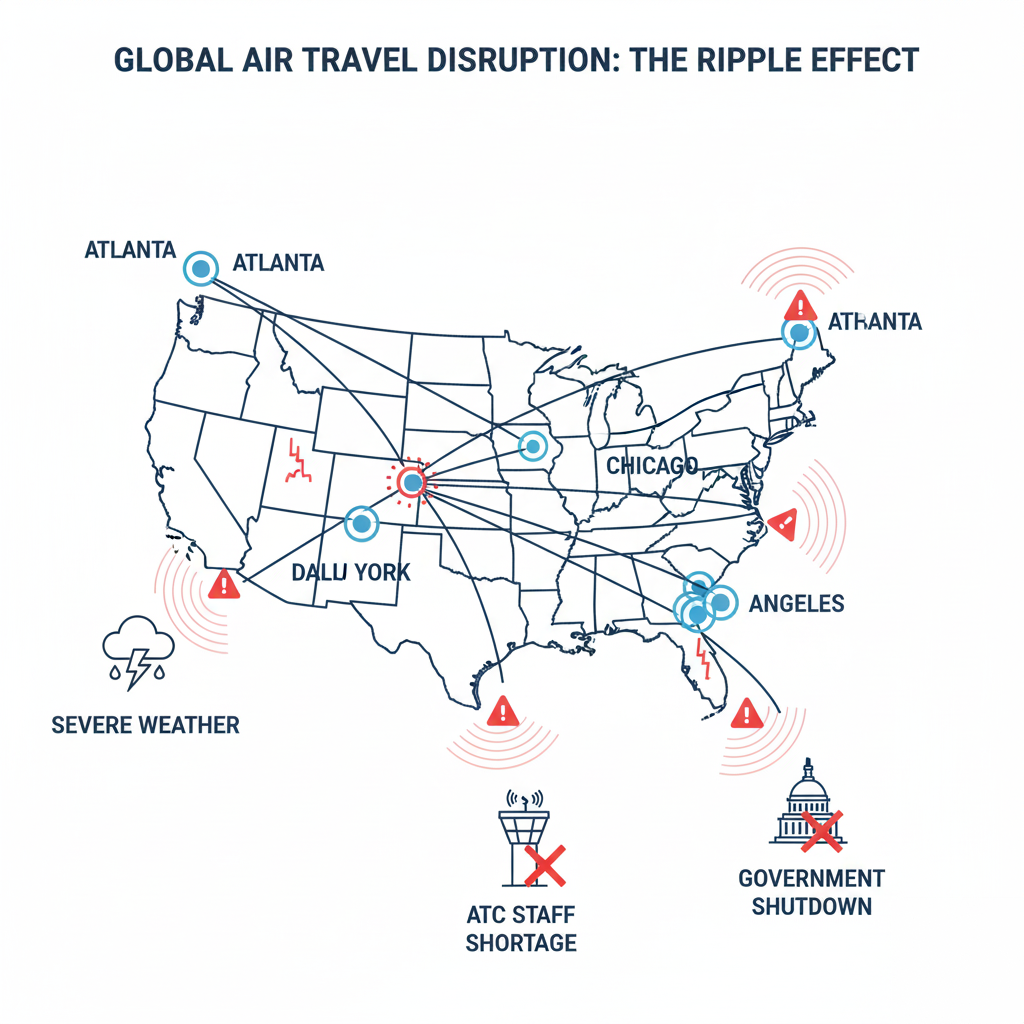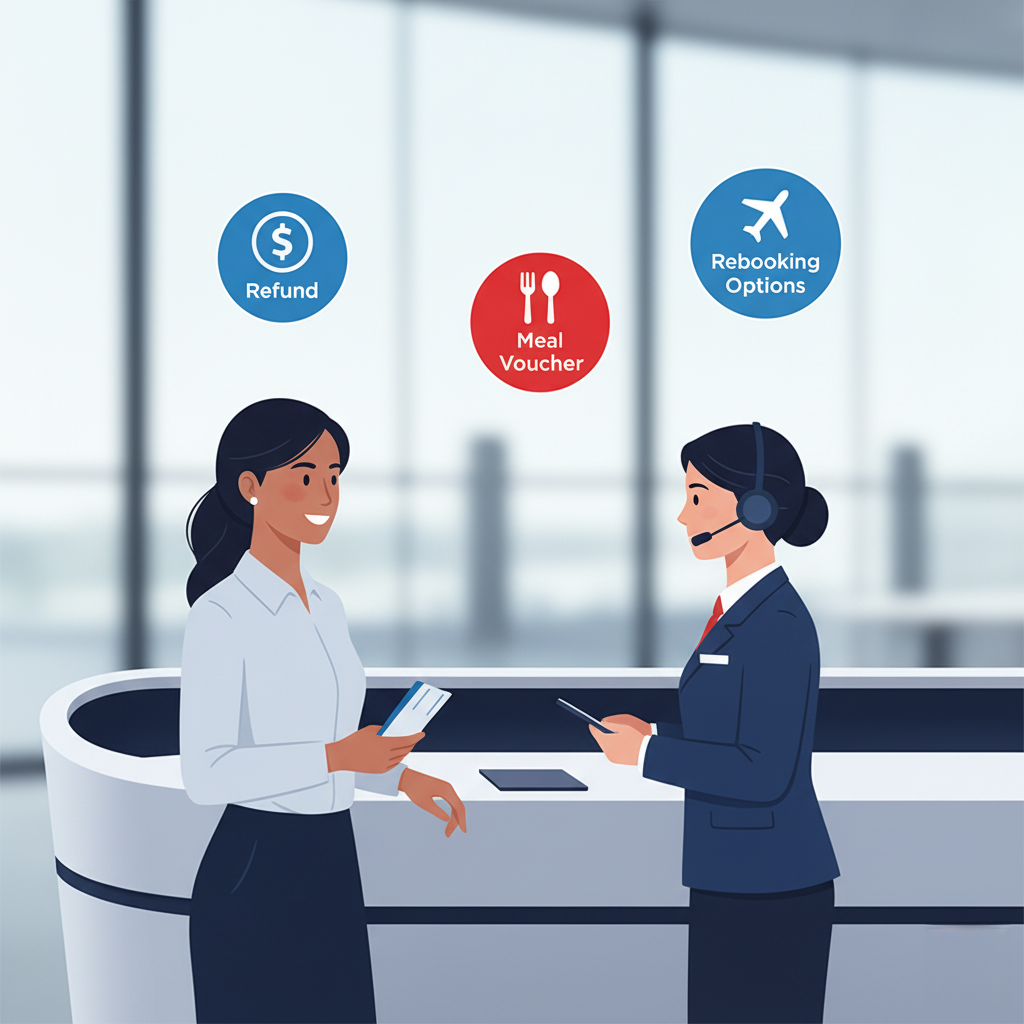Emirates US Airport Delays: If you’ve seen the recent headlines, you know the feeling. A major international airline, Emirates, issued a travel advisory urging its passengers departing from the United States to arrive at the airport a staggering four hours before their flights. This isn’t just a suggestion; it’s a symptom of a larger problem plaguing American skies, causing widespread traveler anxiety due to persistent US airport delays and air travel disruptions. The sense of powerlessness when your flight is delayed or canceled is a universal frustration.
But what if you could trade that anxiety for a clear plan of action? This is your Ultimate Traveler’s Playbook. We’re moving beyond the headlines to give you a single, comprehensive resource to understand the chaos, plan proactively, and regain control when disruptions strike. From the systemic reasons behind the delays to your exact rights as a passenger, this guide is designed to empower you on your next journey.
Why Are US Airports So Chaotic? Understanding the Root Causes of Delays
To effectively navigate the current landscape of air travel disruptions, it’s crucial to understand the deep, systemic issues at play. The frustration you feel at the gate is often the end result of a complex chain of events that started long before your travel day. These are not just random misfortunes; they are symptoms of a system under immense strain.
The Critical Shortage of Air Traffic Controllers
One of the most significant factors contributing to US airport delays is a chronic and critical shortage of air traffic controllers (ATCs). These are the essential personnel who ensure the safe and orderly flow of thousands of flights every day. When their numbers are insufficient, the entire national airspace system loses its resilience. A single weather event or operational hiccup can create a domino effect, leading to widespread delays and cancellations.
This isn’t just anecdotal; it’s a documented national issue. A report from the U.S. Government Accountability Office (GAO) highlighted the severity of the problem, finding that the Federal Aviation Administration (FAA) has consistently failed to meet its own staffing targets at critical facilities[2]. The report revealed a startling statistic: 77% of key air traffic control facilities had staffing levels below the FAA’s established threshold[2]. This understaffing forces the system to operate with a much smaller margin for error, making delays almost inevitable when challenges arise.
How Airline Operations and Government Actions Create Bottlenecks
Beyond the air traffic controller shortage, other factors contribute to the fragility of the system. The impact of government shutdowns, for instance, can be severe. As seen in past events, when ATCs are classified as “essential” employees and forced to work without pay, morale plummets and fatigue sets in, leading to staffing shortages that cripple airport operations.
Furthermore, the FAA itself may order reductions in air traffic to manage the strain on the system, requiring airlines to cut flights during peak periods. This proactive measure, while intended to prevent a total collapse, directly results in widespread flight cancellations for travelers. Compounding this is the prevalent “hub-and-spoke” model used by many major airlines. While efficient for carriers, it means that a significant delay at a major hub like Atlanta, Chicago, or Dallas can send ripple effects across the entire country, delaying flights in cities hundreds of miles away.

Before You Go: Your Proactive Playbook for Booking and Preparation
While you can’t control the weather or FAA staffing levels, you can take strategic steps to significantly minimize your risk of being impacted by air travel disruptions. This proactive playbook focuses on smart planning and preparation, shifting your role from a passive victim of circumstance to an empowered traveler.
Decoding the Emirates Advisory: Why 4 Hours Early?
The recent Emirates travel advisory is a clear signal of the current pressures on the system. When an airline recommends arriving four hours early, it’s a direct response to what they are seeing on the ground. The airline’s statement specified the reason: “Customers departing from any of Emirates’ U.S. gateways are advised to arrive at the airport at least 4 hours prior to their scheduled flight departure due to extended security screening times.”
This advice serves as a benchmark for high-risk travel. If you are flying internationally, during a major holiday, or out of a notoriously busy airport, adopting a similar early-arrival strategy can be the difference between a stressful sprint to the gate and a calm, controlled start to your journey.
Strategic Booking: How to Choose Flights to Minimize Risk
The choices you make during the booking process can dramatically alter your odds of a smooth travel day. Instead of just searching for the cheapest fare, consider these strategic factors:
- Book the First Flight of the Day: Early morning flights are statistically less likely to be delayed. They aren’t waiting on an incoming aircraft from another city that might already be behind schedule, and airports are typically less congested.
- Fly Nonstop Whenever Possible: The simplest way to avoid a missed connection is to not have one. Every layover you add to your itinerary is another opportunity for a delay to derail your plans.
- Choose Airlines with Multiple Daily Flights: If you’re flying a popular route, book with an airline that operates several flights to your destination throughout the day. If your original flight is canceled, you’ll have more rebooking options on the same carrier.
- Be Wary of Layovers in Disruption-Prone Hubs: Check the on-time performance of airports before booking. If you have a choice, avoiding a connection in an airport known for frequent weather delays (like Chicago in winter or Houston in summer) can be a wise move.
Essential Pre-Travel Checklist: Apps, Alerts, and Documents
In the 24 hours before your flight, a few simple actions can equip you with the tools you need to stay ahead of any potential problems.
- Download Your Airline’s App: This is your most powerful tool. You can check in, get gate change notifications, track your inbound aircraft, and, most importantly, often rebook yourself directly in the app if your flight is canceled, bypassing long lines at the customer service desk.
- Sign Up for Flight Status Alerts: Opt-in for text or email alerts from your airline. You’ll be the first to know about a delay or cancellation, often before the departure boards at the airport are updated.
- Confirm Your Contact Information: Take the advice Emirates gives its passengers as a best practice for all travel: “ensure contact details are up to date through its Manage Your Booking portal.” This ensures that automated updates and rebooking options reach you without delay.
- Have Documents Ready: Keep a digital and physical copy of your confirmation numbers, ticket details, and any travel insurance policies. When things go wrong, you don’t want to be scrambling for basic information.

During the Disruption: A Step-by-Step Guide to Taking Control
Despite your best preparations, delays and cancellations can still happen. This is the moment when panic can set in, but it’s also when your playbook becomes most valuable. Here is a clear, step-by-step guide to follow when you receive that dreaded notification.
Step 1: Immediately Check Your Airline’s App and Official Channels
Before you do anything else, open your airline’s app. Airlines have invested heavily in automated rebooking systems. The app will often present you with alternative flight options before you can even speak to an agent.
Pro Tip: Automated rebooking options in the app are almost always faster than waiting in a long line or on hold. If you see a viable option, book it immediately. You can often change it later if a better alternative becomes available, but securing a seat is the first priority.
Step 2: Understand the Reason for the Delay or Cancellation
Politely ask the gate agent or check the airline app for the official reason for the disruption. Is it weather-related? A mechanical issue with the plane? A crew timing-out problem? Knowing the “why” is critical because it directly impacts your rights to compensation and assistance, which we will cover in the next section. An issue within the airline’s control (like maintenance) typically entitles you to more than an “act of God” (like a blizzard).
Step 3: Know Who to Contact and What to Say
If the app doesn’t provide a solution, it’s time to talk to a person. But be strategic.
- The Two-Pronged Approach: Get in the physical line at the customer service desk. While you are in line, call the airline’s customer service number. You are essentially in two queues at once, doubling your chances of getting help faster.
- Be Polite but Prepared: Airline agents are dealing with hundreds of stressed passengers. A calm, polite demeanor will get you much further. Have your confirmation number ready and know what you’re asking for. Instead of saying “What can you do?”, try asking “Can you please rebook me on the next available flight to [Your Destination]? I see there is a 7 PM flight, number 1234.”
- Think Outside the Box: Ask the agent to check for flights with partner airlines or from nearby airports. If you’re stuck in New York, they may be able to rebook you on a flight out of Newark or LaGuardia if JFK is gridlocked.

Know Your Rights: A Plain-English Guide to Passenger Compensation
Feeling powerless during a disruption is often rooted in not knowing your rights. While airline policies can be confusing, the U.S. Department of Transportation (DOT) has established clear regulations that protect you. This is not just advice; this is what you are legally owed.
The Golden Rule: Refunds for Canceled Flights
This is the most important passenger right you have. According to the U.S. Department of Transportation, if an airline cancels your flight for any reason and you choose not to travel, you are entitled to a full refund[1]. This applies even if you purchased a non-refundable ticket. The DOT explicitly states, “if a flight is cancelled, regardless of the reason, the passenger is entitled to a full refund for the unused transportation”[1]. The airline may offer you a voucher or credit, but you are entitled to ask for your money back.
Delays, Vouchers, and Hotels: What Are Airlines *Actually* Required to Provide?
Here is where a common misconception arises. For domestic flights, there are no federal laws that require airlines to provide you with compensation, meals, or hotel rooms if your flight is delayed[1]. However, this does not mean you are out of luck.
Each airline has its own “contract of carriage,” which is the legal agreement between you and the airline. This document outlines the specific policies they will follow in the event of a significant delay, especially one caused by something within their control (like a mechanical issue). Most major airlines will provide meal vouchers for delays over a few hours and hotel accommodations for overnight delays caused by the airline. You should ask the gate agent what the airline’s policy is for your specific situation and refer to their contract of carriage, which is available on their website.
How to Formally File a Complaint with the DOT
If you believe an airline has violated your rights—for example, by refusing to issue a refund for a canceled flight—you have a clear path for recourse. You can and should file a formal complaint directly with the Department of Transportation. The DOT tracks these complaints, investigates them, and can take enforcement action against airlines. This final, empowering step ensures that airlines are held accountable and that your rights as a traveler are respected.

The Final Flight
The reality of modern air travel is that disruptions are often unavoidable. The systemic pressures, from air traffic controller shortages to operational bottlenecks, mean that delays and cancellations will continue to be a part of the travel experience. However, chaos does not have to lead to helplessness.
By adopting this playbook approach, you can fundamentally change your travel dynamic. Understanding the ‘why’ behind the delays provides context and reduces frustration. Planning proactively by booking strategically and using modern tools puts you in a position of strength. Acting decisively with a clear, step-by-step plan during a disruption allows you to navigate the situation effectively. And most importantly, knowing your rights as a passenger empowers you to advocate for yourself and receive what you are owed.
While you may not be able to control the skies, you can absolutely control your preparation and response. You have the playbook to conquer the chaos and regain control of your journey.
Bookmark this guide for your next trip and share your own travel disruption success stories or tips in the comments below.
Disclaimer: This article provides general travel advice and information on passenger rights based on publicly available data. Airline policies and specific situations can vary. Always confirm details directly with your airline and relevant government authorities.
References
- U.S. Department of Transportation. (n.d.). Fly Rights. Retrieved from https://www.transportation.gov/airconsumer/fly-rights
- U.S. Government Accountability Office. (2023). Air Traffic Control: FAA Needs a Better Approach to Address Staffing Challenges (GAO-23-105863). Retrieved from https://www.gao.gov/products/gao-23-105863



